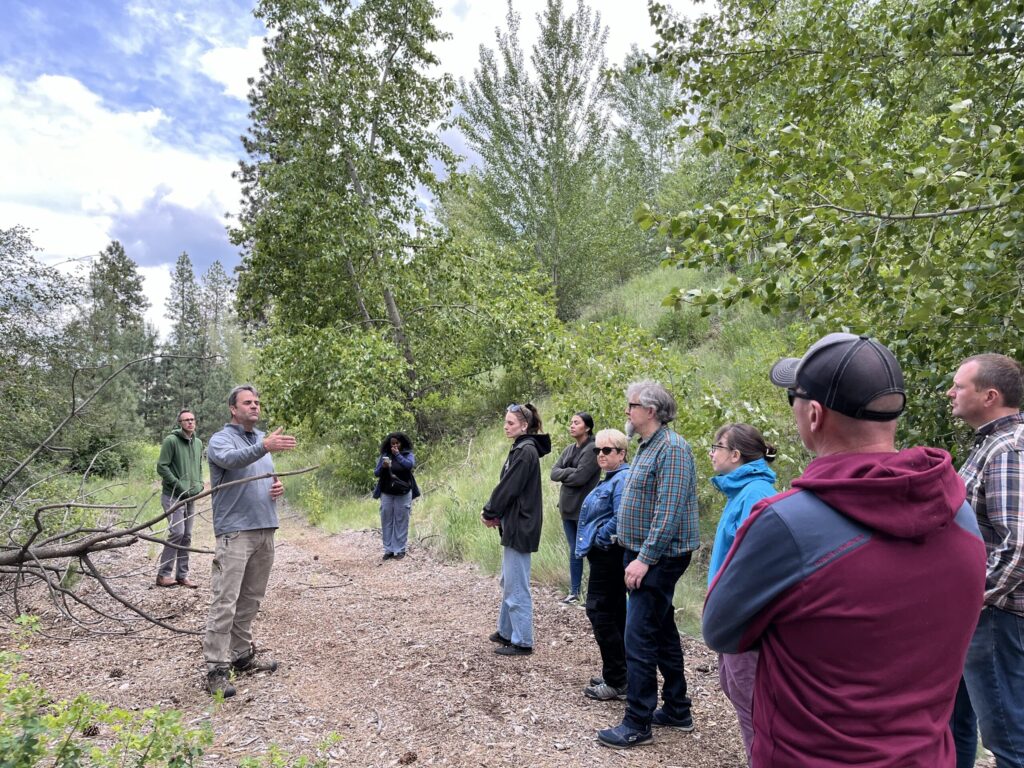SCD’s Forest Program Manager Garth Davis led a 2-hour tour around the organization’s unique property.
Whether you climbed a neighborhood apple tree as a child or enjoy visiting your favorite magnolia in an urban park, you probably have some connection to trees. Thinking about those connections was a logical starting place for PEI’s recent Urban and Community Forestry (UCF) framework writing workshop. The goal was to create a statewide career-connected learning framework for middle and high school students. “We started with the team thinking about their relationships with trees through their family or other life experiences,” says PEI’s Associate Director of Green Jobs Heather Spalding.
The writing team drew from multiple perspectives, including representatives from the Washington State Department of Natural Resources (DNR), the Spokane Tribe of Indians, Spokane Conservation District (SCD), On Track Academy, West Valley School District, Spokane Public Schools, the Office of the Superintendent of Public Instruction (OSPI), Forest Health Watch, OSPI’s Office of Native Education, Washington State University Extension, and Spokane Community College. “It was a diverse group,” says PEI’s Project Specialist Michelle Townshend. “That was one of the highlights.”
On day one, the group became familiar with the writing process and how they could contribute to it. In the afternoon, SCD hosted the workshop and Forestry Program Manager Garth Davis provided a two-hour tour of the organization’s unique property.
“I love that local businesses are partnering together to create less waste while being able to maintain their product. I hope they’ve been an inspiration to others to share things that would be considered waste to one person, but an asset to another.” — Workshop Participant

“They are situated in a very unusual place,” Townshend notes. “It’s an abandoned quarry, and they have been working at restoring the flora and fauna.” SCD has established a mile and a half trail system around the periphery of the property, which includes a greenhouse, a nursery, and a station for reclaiming old wood discovered in their work around Spokane County. “The property is below the water table in some areas, and they’ve set up ponds with native habitats,” says Townshend. “It’s a really good example of a community forest.”
Equity was a key focus of the workshop, and the team used recent experience to consider ways of approaching urban forestry with students. “Different demographics have different relationships with trees,” says Townshend. “The tree canopy program in Spokane ran into pushback from residents of low-income neighborhoods where people were renters rather than owners and/or didn’t want the responsibility of looking after a tree. It was a mismatch, and it caused some unexpected conflict. It’s important when talking with students to make sure they understand that what they may think are good ideas may not be construed the same way by the public.”
The team also considered how to embed five essential questions from the Office of Native Education as standards for tribal perspectives. PEI will continue to work on those standards with support from Shandy Abrahamson of ONE. “We knew this would be a great place to embed tribal cultural connections with trees in an authentic way, and that this would be an important conversation to have with students,” says Townshend.

Beyond the career-connected learning framework for secondary students, PEI is also working with Spokane Conservation District to develop a K-12 urban and community forestry program through funding from an Environmental Protection Agency (EPA) grant. “We need to start educating students all along the way about natural resources jobs,” says Townshend. “This will provide that link between elementary and secondary education.”
The framework is now in draft form, and the next step is for Townshend to add standards and performance assessments. It should be ready for teachers to use by the end of the year.
